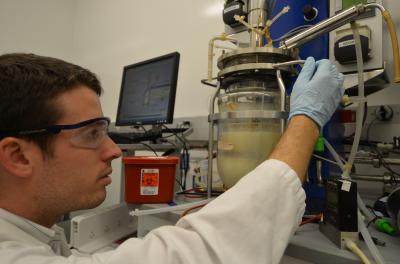
The lear liquid on top contains butanol and acetone, while the opaque gloop at the bottom contains the bacteria that made them.
Robert Sanders photo.
Although battery-powered vehicles are making great strides, it's tough to match the energy densities found in hydrocarbons. So they'll always be an excellent choice for applications where weight or long distances are involved—think airplanes and ships—but our planet has a finite supply of easy-to-extract hydrocarbons. At some point, we'll inevitably need to look for alternatives.
Biofuel is one option with some appeal. Fossil fuels, after all, are simply the result of a bit of time and geology acting on plant matter. We should, in theory, be able to speed that process. So far, however, the easiest thing to produce has been ethanol, which isn't nearly as energy rich as the hydrocarbons in diesel and jet fuels. But a new process that mixes bacteria with traditional catalysts in a single process provides a relatively high conversion of sugar to hydrocarbons.
The process relies on a specific species of bacteria, Clostridium acetobutylicum. Given a source of sugar (which can be obtained by digesting cellulose in plants), these bacteria will produce a mixture of small carbon compounds: acetone, ethanol, and butanol. Although these chemicals can be useful in a number of contexts, they're not great as fuels. The longest of these is only four carbons, and all of them have an oxygen incorporated into their structure.
Read 7 remaining paragraphs | Comments
DIGITAL JUICE
No comments:
Post a Comment
Thank's!